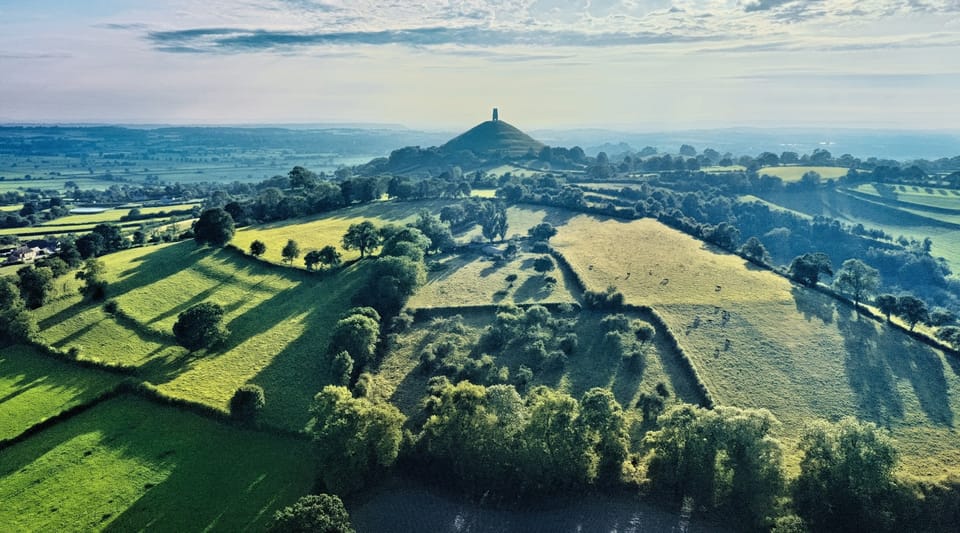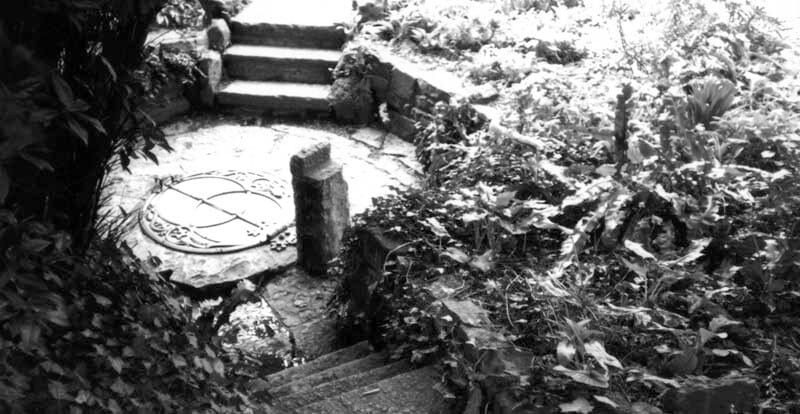Ghosts of Glastonbury, with Margo Williams. The Hollow Hill Exorcism

Haunted Tower on the Tor
HIGH ABOVE Glastonbury town rises a green hill on whose summit stands an old tower, all that remains of the church of Saint Michael on the Tor.
Like autumn mists legends gather about the tor. Some local mystics say Merlin the magician lived here; claim the hill is hollow and unwary souls may find an entrance but no exit because the tor is a hallowed gateway to the Underworld.
Many pilgrim visitors still believe the Holy Grail is hidden at the foot of this hill somewhere down deep in the Chalice Well.
The tower is 13 metres or so of corroding stone and empty arch window. Lichen forms patches of light and dark, bleach white and virulent green.
The church to which it attached is long gone.
Above the tower doorway are remains of stone carvings, now badly eroded. Some of Saint Michael can be identified, locked in a struggle to pin down a dragon. Below is a carved relief of an angel and devil watching a pair of scales in which a soul is weighed.

Horror on the Hilltop
The tower is an eerie, windswept place; and some pilgrims of sensitive disposition say they heard ghostly sounds of human distress and wonder to which part of the Grail story that noise belongs.
In truth it is a tragic tale of human s.crifice that happened in winter 1549.
Records confirm relations between Glastonbury's abbey and its neighbour, the cathedral of Wells fell foul of bitter disagreement, mostly over money and claims of Joseph of Arimathea's burial in the old abbey grounds.
Abbots tried to bring unity in crisis times within the abbey but the Bishop of Wells all too often seemed more than happy to stir things up for worse. Some abbots dedicated their entire year’s profit in getting even with the bishop through courts of law.
Excommunication happened, treachery more often until finally their differences were resolved up on the tor.
Elderly Abbot Whiting finally surrendered to arrest during autumn of 1539 and was locked in a Tower of London cell. When questioned, he yielded the abbey’s treasures to Henry VIII’s commissioners.
Released from the Tower, Abbot Whiting was escorted as prisoner back to Somerset, then into the palace of the Bishop of Wells.
Accused of Robbery, charges were read against the abbot; the verdict delivered: Guilty.
The sentence final, and carried out beside the tower of St Michael on the Tor.
Eye-witness accounts of what happened offered by its ghosts describe a ghastly scene of suffering. Way too nasty to be allowed for public consumption via the internet.
They are shared in the full versions of Ghost Encounters Destiny & Desire.
Instead the story of brave Saint Collen might set a tone more cheerful for the ghosts of the Chalice Well and its secret stash - the Holy Grail.

The God & the Gateway
Archaeological excavations reveal a church building stood on this hill since the AD 600s when the summit was cleared of trees, levelled and a small monastery established.
However, the tor cracked open and swallowed the building. The tower too would have fallen long ago but for rocks, rubble and most recently, tons of concrete poured into the hill to prop it up.
Who knows if the ancient Britons who lived hereabouts since long before Saint Joseph’s arrival warned the industrious monks that anything built up there would not last, because it is a gateway to the Underworld.
Ancient Welsh legend claimed Glastonbury belonged to Gwynn, god of the de.d; and the tor offered an entrance into his realm.
In reply Christian-minded people in the town say their tor belongs to Saint Collen, the man who defeated the pagan god within the hill. He remains there as guardian to ensure the gates of Hell open in only one direction.
The Saint Gets an Invite to the Underworld
The legend of the Hollow Hill told of how Gwynn’s father was god of the river Severn. Folk decorated their flags and ornaments with Gwynn’s symbol of a red dragon; and all those who passed their final summer expected him to greet them into the Otherworld, for Gwynn received the souls of the de.d.
However, Christian legend claimed he was exorcised by Saint Collen who, during the AD 600s, moved in to a cave at the foot of the tor.
Collen was admired by the pope as a man who made it his business to confront anyone who held high regard for the old Gods; and one morning when Collen overheard two locals talking of Gwynn in respectful tones, he decided it was time to change their minds.
The villagers stared at him, appalled at what he had said about Gwynn the god. ‘Talk like that, Christian, and Gwynn will want to see you,’ they replied. ‘He is hospitable, but not one to insult.’
The saint told them Gwynn was the devil and he cared not, but noted how the two villagers would hear no dissent, and so the saint resolved to try again another day.

LATER THAT NIGHT as Collen sat in his cave at the foot of the tor, a stranger entered and told him Gwynn wanted to talk. The saint told the messenger he was too busy.
The being stood implacable to that refusal and invited the saint to be up on the tor summit at noon next day; and with that said the messenger vanished from the cave.
Next morning Collen made his usual rounds of the streams. He fished, he prayed but did not climb the hill; and late that night again came the messenger. This invitation too was ignored. The following night the being came to his cave and Collen resolved to face Gwynn.
‘I shall be there, tell your master.’
What Happened to the Saint in the Underworld
Collen prayed throughout the night and well into next morning. As noon approached he strapped on sandals, wrapped his black robe tight about him and tucked inside a phial of holy water, and then began the steep ascent.
On the high summit he waited shivering in the cold wind, when suddenly the wind stopped...
...And just as suddenly the saint found himself standing in a cavernous chamber. A huge figure seated on a throne of gold stared interestedly down at him.
Luscious lovely beings gathered in the hall, mostly naked, one of whom approached him carrying a golden platter on which were arranged delicate cakes and a tiny goblet of wine.
Gwynn gestured to Collen to take something from the platter but the saint refused. Beneath his black robe he fingered the cork of his hidden phial.
‘Drink, eat,’ offered Gwynn.
‘I do not eat the leaves of a tree,’ was Collen’s reply, so legend told.
Gwynn stared at the saint. These new mortals called themselves the Sons of Light and offered one hundred days remission from sin for every tree they felled on the tor. What, he wondered, had these people against trees?
And as for remission from sin, Gwynn laughed. The ground shook.
‘What amuses you?’ asked Collen.
‘We welcome all to this realm, little mortal, though some do find it difficult to leave.’

Where is the Exit?
Collen looked for a way out but saw only beautiful beings gesturing for him to remove his clothes.
‘You see my people, when they bother to dress it is in the colours of Annwn: red and blue. Exquisite is it not? And as for the cloth...’
Gwynn was about to ask why the Sons of Light chose the cloth of darkness, but the saint’s hand appeared from beneath his robes and Collen poised ready to pop the cork.
‘The cloth is fine,’ agreed the saint. ‘But red and blue are the colours of hell!’ Collen pulled cork from phial and ran around the cavern splashing holy water on everything he could...
...And suddenly Collen stood alone shivering in the dark on the tor top, the wind howled in his ears; all else had vanished.
‘That’s the end of Gwynn,’ said he. ‘I shall now tell the locals.’
And when next he saw them to recount how bravely he had defeated the god within the hollow hill, the villagers shook their heads in wonder, but few were convinced of the saint’s success.
The Chalice Well
At the foot of the tor is a valley divided by a grey stone wall. On one side rises the White Spring whose water once flowed through a cavern of crystal and draws its name from the high calcium content it contains.
On the other side of the wall is the Blood Spring, the Chalice Well, whose water is red and rises through a landscaped garden of shady trees, chirpy birds and secluded seats.
For many centuries Christian legend has claimed the Blood Spring’s water turned red in sympathy when Joseph of Arimathea hid here the silver phials containing the blood of Jesus, or the Chalice of the Last Supper.
No one now is certain which of these objects was hidden. But there is proof. The red colour of the water is God’s confirmation of this great secret.
Science insists this water is red and tastes as it does because of the high iron content it contains. But even today countless thousands of pilgrims visit the Chalice Well garden and stare in wonder.
It is peaceful now, but no longer can questers enter its hole and tear out earth and rock in search of the Grail.

A Ghost of the Grail
The Chalice well is haunted, unsurprisingly.
Its ghosts did not say how long they had waited, though seemed aware of the passing of time. Probably informed by the countless pilgrims who followed them to that place. And how many times had they heard the question:
‘Is it really down there? Go on, open the lid.’
Bert, one of the unlucky pair found waiting sentry beside the Chalice Well was unpleasantly surprised to find himself a ghost of the Grail.
“…This place holds me. Escape I cannot,” he complained. “The holy well some said, Jesus drank the water coming here with his uncle Joseph, yet I knew this was not true. But surely it was holy if the stories that were told had helped folk to be cured, and to be happy?
I lived in a nearby village, came here often, knelt by the well and prayed. ‘Twas different then, no gardens around it like now. I was often ailing with a chest complaint and the rheums. Was the unhappiest of men."
He paused thoughtful on that bitter fact of life.
"They called me bad-tempered Bert,' he continued. "Still I came. I had money, yet often passed by a beggar, let a crippled child starve. Is that why I am here? I did pray for the poor in church and by the holy well. Seems it did not count as am still here. The well is not holy, how can it be?
Have learnt it’s what a man does that counts. Learned that since my wait by the well, not by prayer. You do much by helping me, as can escape at last.”
Thank you for your company on this short tour of Glastonbury Tor mysteries and legend. If you would like to know more about Margo Williams' investigations; and the ghosts that remained; plus other matters of destiny and desire, read this book. Now available from Amazon.
